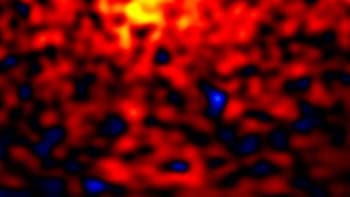
Physicists in China want to widen the search for dark matter using a minuscule levitating oscillator. By tuning the resonant frequency of their sensor across three orders of magnitude, they say they should be able to place new lower limits on the interaction strength of putative low-mass dark matter with an equally large range of masses. However, they have still to show that they can screen out all possible sources of noise.
Scientists inferred the presence of dark matter in the universe decades ago, having observed that stars far from the centre of galaxies rotate more quickly than expected. Despite much effort in the meantime, however, researchers have still to detect any dark matter directly. The leading candidate for many years has been weakly interacting massive particles (WIMPs), which weigh 1010–1012 eV/c2 and tie in with supersymmetry theory. But multiple searches at the Large Hadron Collider at CERN and at dedicated underground facilities have so far drawn a blank.
At the same time, researchers have stepped up the hunt for much lighter particles. Most prominent among these is the axion, a spin-0 boson with a mass somewhere between 10-6 and 10-3 eV/c2 that was originally proposed to resolve a quandary with the strong nuclear force. But beyond this lies a zoo of hypothetical “axion-like particles” (ALPs), which, unlike axions themselves, can in principle take on any of a vast range of masses and interaction strengths.
Coherent waves
Searching for these particles using mechanical oscillators relies on the fact that such low-mass and therefore abundant entities would behave as coherent waves. As the Earth passes through the cloud of dark matter thought to envelop the Milky Way, the wavelike nature of ALPs would lead to a periodic variation in the motion of a suitably sensitive oscillator. The size of the effect would be proportional to the number of neutrons in the detector and a specific but unknown coupling strength, while the oscillation frequency would be proportional to the ALP mass. Any variation at some specific frequency that couldn’t be explained by more humdrum noise sources might therefore indicate the presence of dark matter.
Researchers have looked for such modulations using France’s MICROSCOPE space mission and experiments on the ground. In one ground-based experiment, Eric Adelberger and colleagues at the University of Washington in the US monitored the movement of a rotating torsion balance. Obtaining a null result after analysing nearly seven years of data, in 2019 they were able to impose strict new limits on interaction strengths of about 10-9–10-4 Hz. This corresponds to particle masses of 10-23–10-18 eV/c2.
In the latest work, Jiangfeng Du at the University of Science and Technology of China in Hefei and colleagues in Hefei and Nanjing instead turn their attention to a magnetically levitated oscillator. A discovery in this case would come in the form of an enhanced vertical oscillation at some particular frequency beyond that expected from straightforward thermal vibrations.
Two tiny spheres
The oscillator – which has yet to be built – would consist of two tiny levitating spheres joined by a thin vertical glass rod. The uppermost sphere, a diamagnet measuring 1 mm across, would be held inside a ring of magnets. The lower one, a paramagnet with a radius of only 11 μm, would be suspended just above a smaller set of magnets (see figure). As the connected spheres move up and down their motion would be monitored by measuring the scattering of a laser beam from the upper sphere.
Du and colleagues say that the sensitivity of the oscillator could be enhanced by varying its resonant frequency. The idea is to move the lower magnet up and down, so varying the distance between it and the lower sphere. Smaller distances would mean higher magnetic gradients, which in turn would yield lower resonant frequencies. In this way they could probe frequencies of 0.1–100 Hz.
The researchers explain that experiments would involve monitoring the oscillator’s motion continuously for just over a day at a time, scanning its resonant frequency across the range as they do so. By repeating this process about 100 times, they calculate that they should be able to push down the upper limit on ALP coupling strength for masses of 10-16–10-13 eV/c2 by at least an order of magnitude compared to previous results.
Minimizing noise
This would involve cutting out various noise sources. It would limit unwanted vibrations through a multi-stage suspension system and minimize thermal noise by operating at just 30 mK. It would also reduce measurement noise in the form of detector imperfections and laser pressure fluctuations. The researchers acknowledge that the suspension system cannot filter out seismic waves, tidal forces and other low-frequency interference, but they are looking to deal with this by making better use of active vibrations to cancel out noise.

Squeezed light boosts the search for dark matter axions
What is more, they say it should be possible to extend the search for ALPs by employing a sensor array – enhancing the sensitivity by at least the square root of the number of detectors.
David Moore of Yale University in the US is enthusiastic about the new research, describing it as “a nice proposal” for using mechanical sensors to hunt for dark matter. But he emphasizes just how hard it can be to eliminate noise, having himself had to battle with the tiniest of vibrations when searching for dark matter using a minuscule mass levitated optically. “Some of the background events arose from just having people in the room talking,” he recalls.
The research is described in Chinese Physics Letters.



